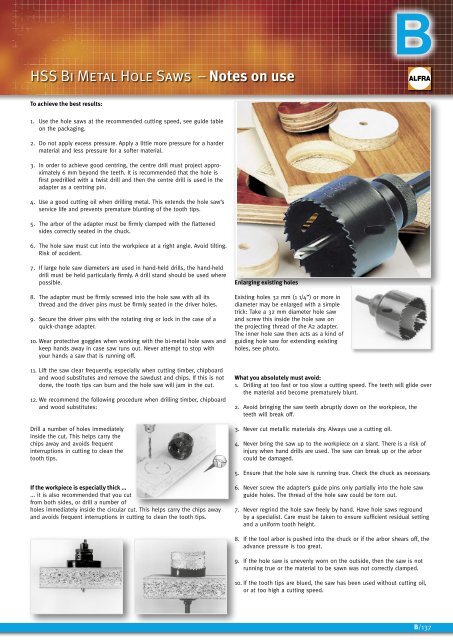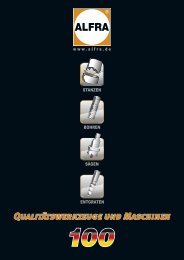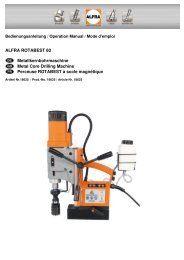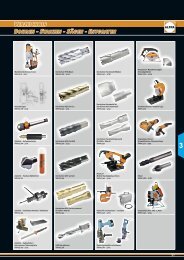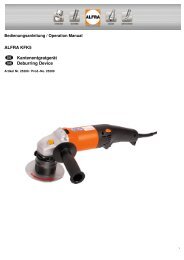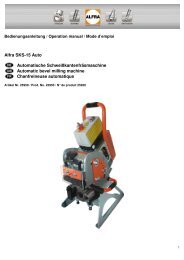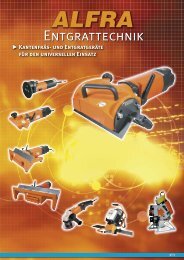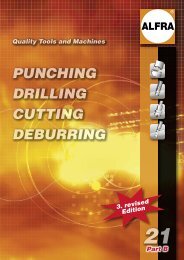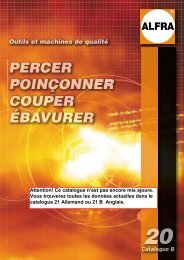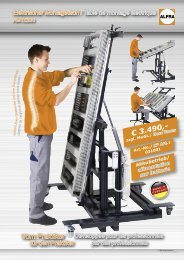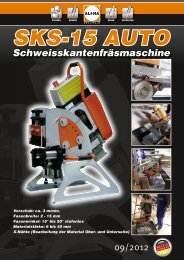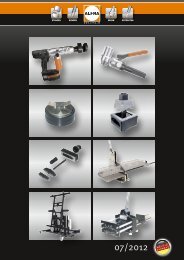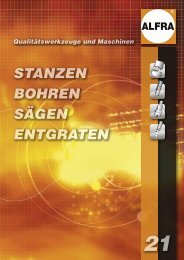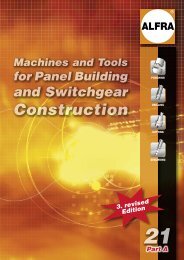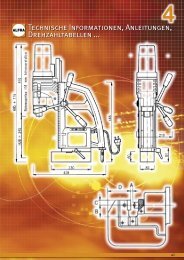You also want an ePaper? Increase the reach of your titles
YUMPU automatically turns print PDFs into web optimized ePapers that Google loves.
HSS Bi Metal Hole Saws – Notes on use<br />
To achieve the best results:<br />
1. Use the hole saws at the recommended cutting speed, see guide table<br />
on the packaging.<br />
2. Do not apply excess pressure. Apply a little more pressure for a harder<br />
material and less pressure for a softer material.<br />
3. In order to achieve good centring, the centre drill must project approximately<br />
6 mm beyond the teeth. It is recommended that the hole is<br />
first predrilled with a twist drill and then the centre drill is used in the<br />
adapter as a centring pin.<br />
4. Use a good cutting oil when drilling metal. This extends the hole saw‘s<br />
service life and prevents premature blunting of the tooth tips.<br />
5. The arbor of the adapter must be firmly clamped with the flattened<br />
sides correctly seated in the chuck.<br />
6. The hole saw must cut into the workpiece at a right angle. Avoid tilting.<br />
Risk of accident.<br />
7. If large hole saw diameters are used in hand-held drills, the hand-held<br />
drill must be held particularly firmly. A drill stand should be used where<br />
possible.<br />
8. The adapter must be firmly screwed into the hole saw with all its<br />
thread and the driver pins must be firmly seated in the driver holes.<br />
9. Secure the driver pins with the rotating ring or lock in the case of a<br />
quick-change adapter.<br />
10. Wear protective goggles when working with the bi-metal hole saws and<br />
keep hands away in case saw runs out. Never attempt to stop with<br />
your hands a saw that is running off.<br />
11. Lift the saw clear frequently, especially when cutting timber, chipboard<br />
and wood substitutes and remove the sawdust and chips. If this is not<br />
done, the tooth tips can burn and the hole saw will jam in the cut.<br />
12. We recommend the following procedure when drilling timber, chipboard<br />
and wood substitutes:<br />
Drill a number of holes immediately<br />
inside the cut. This helps carry the<br />
chips away and avoids frequent<br />
interruptions in cutting to clean the<br />
tooth tips.<br />
If the workpiece is especially thick ...<br />
... it is also recommended that you cut<br />
from both sides, or drill a number of<br />
holes immediately inside the circular cut. This helps carry the chips away<br />
and avoids frequent interruptions in cutting to clean the tooth tips.<br />
Enlarging existing holes<br />
Existing holes 32 mm (1 1/4”) or more in<br />
diameter may be enlarged with a simple<br />
trick: Take a 32 mm diameter hole saw<br />
and screw this inside the hole saw on<br />
the projecting thread of the A2 adapter.<br />
The inner hole saw then acts as a kind of<br />
guiding hole saw for extending existing<br />
holes, see photo.<br />
B<br />
What you absolutely must avoid:<br />
1. Drilling at too fast or too slow a cutting speed. The teeth will glide over<br />
the material and become prematurely blunt.<br />
2. Avoid bringing the saw teeth abruptly down on the workpiece, the<br />
teeth will break off.<br />
3. Never cut metallic materials dry. Always use a cutting oil.<br />
4. Never bring the saw up to the workpiece on a slant. There is a risk of<br />
injury when hand drills are used. The saw can break up or the arbor<br />
could be damaged.<br />
5. Ensure that the hole saw is running true. Check the chuck as necessary.<br />
6. Never screw the adapter‘s guide pins only partially into the hole saw<br />
guide holes. The thread of the hole saw could be torn out.<br />
7. Never regrind the hole saw freely by hand. Have hole saws reground<br />
by a specialist. Care must be taken to ensure sufficient residual setting<br />
and a uniform tooth height.<br />
8. If the tool arbor is pushed into the chuck or if the arbor shears off, the<br />
advance pressure is too great.<br />
9. If the hole saw is unevenly worn on the outside, then the saw is not<br />
running true or the material to be sawn was not correctly clamped.<br />
10. If the tooth tips are blued, the saw has been used without cutting oil,<br />
or at too high a cutting speed.<br />
B/137


